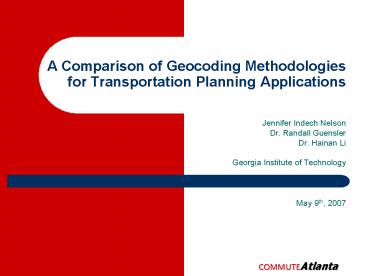A Comparison of Geocoding Methodologies for Transportation Planning Applications - PowerPoint PPT Presentation
1 / 23
Title:
A Comparison of Geocoding Methodologies for Transportation Planning Applications
Description:
... Data Acquisition in Transportation Commute Atlanta. Commute Atlanta study ... All figures created by Commute Atlanta researchers, except spatial interpolation ... – PowerPoint PPT presentation
Number of Views:34
Avg rating:3.0/5.0
Title: A Comparison of Geocoding Methodologies for Transportation Planning Applications
1
A Comparison of Geocoding Methodologies for
Transportation Planning Applications
- Jennifer Indech Nelson
- Dr. Randall Guensler
- Dr. Hainan Li
- Georgia Institute of Technology
May 9th, 2007
2
Agenda
- Purpose
- Background
- Process
- Acquisition of data
- QAQC
- Final data set
- Analysis
- Positional Accuracy
- Polygon Assignment
- Discussion
- Assess the accuracy of various geocoding methods
to provide insight on field data collection,
calibration of travel demand model inputs, and
automation of travel behavior analysis
3
Geocoding and How It Is Used in Transportation
Planning
- Geocoding - Generation of coordinates within a
spatial geographic framework, where single points
serve as proxies for places - Used to
- Prepare TAZ data from travel diary studies for
Travel Demand Model development - Better represent spatial travel patterns
- Verify 4-step model components
- Provide primary input to next generation
behavior-based micro-simulation Travel Demand
Models
4
Methods of Obtaining Geocoded Coordinate Data
- GPS field surveys (active)
- Aerial image processing
- Address matching
- Road network address interpolation
- GPS tracking (passive)
Increased automation
5
Geocoding Address Matching Vs. Interpolation
Linear Address interpolation
11 - Check address existence / integrity from
list inc. other attributes
Estimate position from spatial reference (network
link)
Assign coordinates
Address Interpolation
Address Matching
6
GPS and GIS Data Acquisition in Transportation
Commute Atlanta
- Commute Atlanta study
- GPS-instrumented vehicle tracking
- 3 years, second-by-second
- 487 vehicles, 268 households
- 1.8 million trips
7
Data for Comparative Analysis
- Two days of parallel data in March 2004 from 137
HHs - Travel diary self-reported locations
- GPS recorded trip files
- Parcel-level geographic reference
- GIS shapefiles generated by MPO and individual
counties (Fulton and Gwinnett Counties)
8
Example of GPS Trip Ends
All GPS Trip-Ends in 13-County Region during
travel diary survey period
9
Final Data Format
- Each location record has three associated
coordinates - GPS trip-end point
- Parcel centroid
- Interpolated location (street network)
- Characteristics
- Unique ID
- Area
- Land use
- TAZ
Centroid
Geocode w/ offset
40
GPS
10
Data Quality Issues GPS/Diaries
- Travel diaries versus GPS trip-ends
- Under-reporting of visited locations in travel
diaries - GPS wander
- Dependent on weather, satellite, and hardware
conditions - Primarily occurs at lt 5 mph
- Data point is last GPS coordinate at engine-off
11
Data Quality Issues Reference
- GIS parcel boundaries and centroids
- Not all parcels have existent or correct address
data - Topology errors may lead to inaccurate centroid
calculation - Road network geocoding
- Uses national database generated by NavTeq and
TeleAtlas, may not have current/correct address
ranges
12
The Incredible Shrinking Data Set
Metro Atlanta (13 counties )
Two-county subset
- Fulton 195 locations, 119 unique
- Gwinnett 129 locations, 75 unique
13
Analysis Positional Accuracy
- Complete (3-source) data only 324 points (194
unique) - 195 Fulton, 129 Gwinnett
- Compare
- GPS trip-end data with parcel centroids
- Interpolated addresses with parcel centroids
- GPS trip-end data with interpolated addresses
- Further comparison according to
- Land use
- Parcel size (e.g. lt 5 acres, gt 5 acres)
14
Positional Accuracy GPS vs Geocode
- GPS significantly more accurate than geocoding
- Combined 273 vs 402
- (Single-family) residential locations more
accurate than non-residential parcels - Smaller parcels more likely than larger parcels
to have better positional accuracy for all
methods
15
Positional Accuracy Land Use / Size
- GPS to centroid accuracy has some correlation to
parcel size, but land use and typical parking
location are probably more important - Within particular land uses, inverse relationship
of accuracy to area
16
Results Polygon AssignmentParcel and Blockgroup
- Match rates to potential TDM inputs
- Parcels, Census Blockgroup
17
Results Polygon AssignmentLand Use and TAZ
- Match rates to potential TDM inputs
- Land Use, Traffic analysis zone (TAZ)
18
Polygon Assigment Rate TAZ
- Non-residential locations especially prone to
mis-assignment
19
Discussion
- Reference Data
- Must be accurate and standardized!
- Positional Accuracy
- Method of creating geocoded data depends on
degree of accuracy needed - Most to least accurate (lt10 ft to gt1000 away)
Address matching, GPS, interpolation - Off-site parking creates issues for passive
determination of trip purpose from GPS data
20
Discussion
- Polygon Assignment
- TAZ hit rate lower than expected, particularly
for non-residential locations - Degree of zoning homogeneity and size of parcels
are directly proportional to chance of matching
correct land use for TDM verification
21
Next Steps
- Assess method of GPS tracking and data gathering
- Quantify error associated trip-ends
- Determine how to evaluate large parcels /
campuses - Internal destinations, land uses
22
Any Questions?
Please use the Microphone
22
23
Appendix Sources and Additional Figures
- All figures created by Commute Atlanta
researchers, except spatial interpolation
picture (slide 5 from Three Standard Geocoding
Methods Dramowicz, 2004) and Google Earth
imagery (slides10 and 21)
- Right GPS position off due to urban canyon (tall
buildings in Midtown Atlanta)

